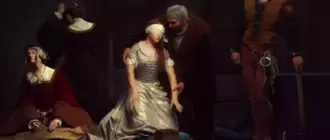It is a technique of scratching out a wall covered with one or more multi-colored layers of plaster or the surface of ceramic dishes with a sharp tool. Sgraffito has long been used for the original decoration of buildings and ceramics by applying an original drawing or ornament to the base.
It is an excellent alternative to traditional fresco paintings in humid regions. The image scratched on colored plaster is well preserved for many years and does not deteriorate under the influence of moisture.

Features of sgraffito
Sgraffito is a special artistic technique that is fundamentally different from both painting and mosaics. The finished image also cannot be called embossed, since the base is scratched to a shallow depth.
The standard sgraffito technology includes several sequential stages:
- Preparation (leveling and priming) of the base.
- Applying one or more layers of multi-colored plaster to it.
- Scratching an image on the wall according to a pre-selected template.
The craftsman has to work quickly, while the top layer of the plaster remains wet and amenable to processing. This is the main difficulty in using technology. But after the final drying of the solution, the relief image becomes strong and durable.

The sgraffito technique can be used not only for exterior, but also for interior decoration of buildings. With its help, small wall panels and large-scale panoramic images are created. Sgraffito is also used to highlight individual architectural elements (niches, cornices, rustic stones, friezes) and original decorative design of the ceilings of premises.
History
The history of sgraffito dates back to the heyday of the ancient Egyptian civilization. The oldest pottery specimens with scratched images are more than 4,000 years old. The ancient technique of decorative finishing of ceramic ware from the Egyptians was later borrowed by the Greeks, and then by the Roman craftsmen.
The classic technology of scratching the walls of buildings on raw plaster first appeared in the Early Renaissance. During the 15th-16th centuries, sgraffito was very popular in Rome, Florence, Pisa, and other regions and cities of Italy.
The most famous masters of that era were Polidoro Caldara and Maturino da Firenze. Unfortunately, almost all the sgraffito that adorned the facades of houses and palaces in Rome were irretrievably lost. Only their images on old engravings have survived to this day.

From Italy, the original wall decoration technique gradually spread to other European countries.
Sgraffito gained the greatest popularity on the territory of modern Germany, Austria and the Czech Republic. Numerous examples of the work of skilled craftsmen still adorn the facades of buildings in the ancient cities of Bavaria, Thuringia and Moravia.
At the turn of the 19th and 20th centuries, interest in sgraffito increased significantly with the onset of the Modern era in art. Many artists began experimenting with ancient techniques. Among the best examples of the work of the masters of that time, one can single out the original facade of the Cauchy House in Brussels and the interior decoration of the Church of the Holy Virgin Mary in Wales by the Englishman Heywood Sumner.

Sgraffito was also very popular in the Soviet Union. From the early 1930s until the collapse of the state, this technique was widely used in the design of the facades of public and residential buildings. Hundreds of Soviet artists created propaganda images glorifying the greatness of the country and the achievements of the people. Many examples of this monumental art can still be found in all corners of the former Soviet Union.
Nowadays, sgraffito, even at a stretch, cannot be called a popular technique for decorating the walls of buildings. Modern builders use new technologies and materials, and completely different ideals of exterior and interior design prevail in architecture.









